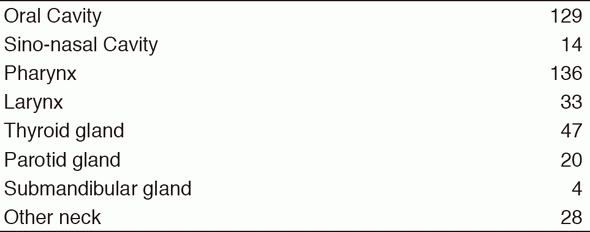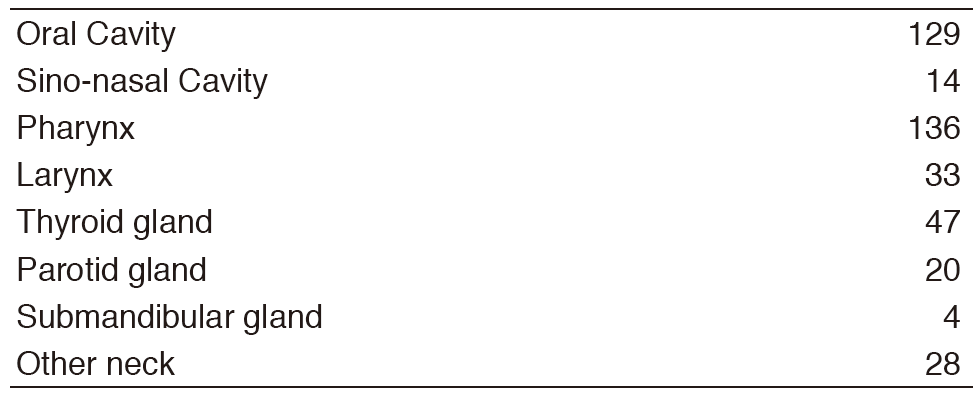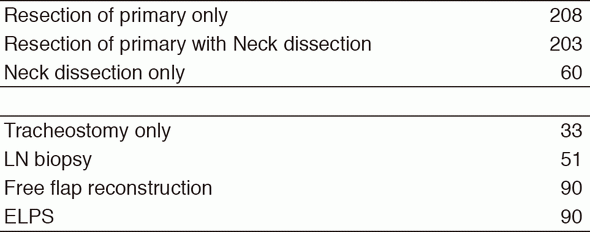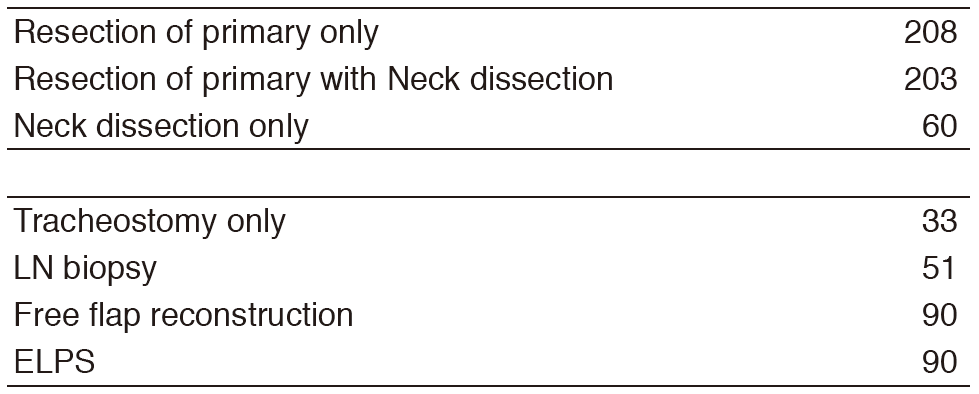HOME > Publication & Reports > Annual Report 2016 > Hospital East
Department of Head and Neck Surgery
Ryuichi Hayashi, Takeshi Shinozaki, Toshifumi Tomioka, Takashi Maruo, Wataru Okano, Takayuki Taruya, Masahiro Rokugo, Nayuta Tsushima
Introduction
Surgical treatment of head and neck cancer must meet two contradictory requirements: (1) the resection volume must be sufficiently large to remove all cancer cells, and (2) the resection volume should be sufficiently small to preserve important functions such as swallowing, speech, vision, and cosmetic appearance. The Department of Head and Neck Surgery resolves these conflicting requirements mainly by two distinct approaches: (1) conservative surgery, and (2) extensive resection with microsurgical reconstruction. We have been developing various larynx-preserving operations sice the establishment of the National Cancer Center (NCC). These procedures include a partial laryngectomy which is indicated for T1/T2 recurrent glottis carcinoma after radiotherapy. Another example of conservative surgery is partial hypopharyngectomy with preservation of the larynx for hypopharyngeal carcinoma. Recently, trans-oral resection for pharyngo-laryngeal cancer has been increasing as minimal invasive surgery. On the other hand, extensive resection with microsurgical reconstruction is designed to minimize loss of function following ablative surgery by employing the microsurgical transfer of various flaps.
Our team and what we do
The current treatment policy for head and neck cancer is multimodal therapy. To effectively implement available therapeutic modalities, five staff surgeons at our department work closely with plastic surgeons, radiotherapists, medical oncologists, pathologists, dentists, psycho-oncologists, nurses, and other hospital staff. To facilitate regular communication among the members of this large team, several weekly conferences are conducted. The number of operations was 522 (471 cases under general anesthesia, and 51 cases under local anesthesia). 90 cases of all underwent ELPS (Endoscopic laryngo-pharyngeal Surgery) and 90 cases underwent free flap reconstruction (Tables 1, 2).
Table 1. Number of patients with primary resection


Table 2. Type of procedures


Research activities
1.Programmed Death Ligand-1 Expression Is Associated With Poor Disease Free Survival in Salivary Gland Carcinomas
Positive PD-L1 expression was significantly associated with poor disease free survival of SGCs, suggesting that antibody therapies targeting PD-1/PD-L1 may have potential application in SGCs.
2.Anatomic Invasive Depth Predicts Delayed Cervical Lymph Node Metastasis of Tongue Squamous Cell Carcinoma
Multivariate analysis demonstrated that anatomic invasive depth was an independent predictive factor for delayed CLNM. Precise elucidation of AID may be useful for the preoperative decision for performing elective neck dissection.
3.Management of the thyroid gland by salvage surgery for hypopharyngeal and cervical esophageal carcinoma after chemoradiotherapy
Total thyroidectomy is not always necessary during salvage total pharyngolaryngoesophagectomy for piriform sinus and pharyngeal wall carcinoma. The preservation of the thyroid gland will contribute not only to the prevention of local complications but also to the preservation of the parathyroid function.
Clinical trials
We participate in Phase II/III Trial of Postoperative Chemoradiotherapy Comparing 3-Weekly Cisplatin with Weekly Cisplatin in High-risk Patients with Squamous Cell Carcinoma of Head and Neck (JCOG 1008) and Dose finding and confirmatory trial of superselective intra-arterial infusion of cisplatin and concomitant radiotherapy for patients with locally advanced maxillary sinus cancer (JCOG 1212).
Education
Three senior residents were recruited to our department in 2016. Three medical students visited our department for training. Our department was assigned as one of the observation centers of the International Federation of Head and Neck Oncologic Societies (IFHNOS) fellowship program from 2014. We will accept doctors and students actively not only from Japan but also from overseas.
Future prospects
Trans-oral resection by ELPS has become one of the standard surgical procedures for early pharyngeal cancer. We are going to operate the clinical study to evaluate the efficacy of trans-oral resection for superficial pharyngeal cancer.
List of papers published in 2016
Journal
1.Mukaigawa T, Hayashi R, Miyazaki M, Shinozaki T, Tomioka T, Fujii S. Cystadenocarcinoma of the salivary glands with potential lymph node metastasis. Auris Nasus Larynx, 43:340-344, 2016
2.Okano W, Hayashi R, Omori K, Shinozaki T. Management of the thyroid gland by salvage surgery for hypopharyngeal and cervical esophageal carcinoma after chemoradiotherapy. Jpn J Clin Oncol, 46:631-634, 2016
3.Mukaigawa T, Hayashi R, Hashimoto K, Ugumori T, Hato N, Fujii S. Programmed death ligand-1 expression is associated with poor disease free survival in salivary gland carcinomas. J Surg Oncol, 114:36-43, 2016
4.Mitani S, Tomioka T, Hayashi R, Ugumori T, Hato N, Fujii S. Anatomic Invasive Depth Predicts Delayed Cervical Lymph Node Metastasis of Tongue Squamous Cell Carcinoma. Am J Surg Pathol, 40:934-942, 2016
